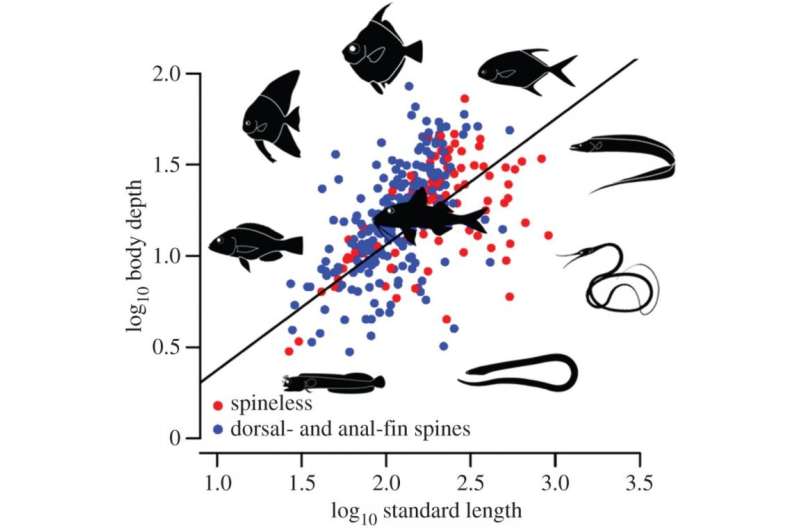The phylogenetic regression between log10 standard length and log10 body depth for families that have dorsal- and anal-fin spines (blue), and those that do not (red). Silhouettes illustrate some of the extremes of body shape, starting at the bottom left and going anti-clockwise: Chaenopsidae, Moringuidae, Nemichthyidae, Alepisauridae, Bramidae, Caproidae, Ephippidae and Cichlidae, with Mullidae in the center. Credit: Proceedings of the Royal Society B: Biological Sciences (2015). DOI: 10.1098/rspb.2015.1428
(Phys.org)—A trio of researchers with the University of California's Department of Evolution and Ecology has found a predictable relationship between the size of predator fish mouths and the shape and spine characteristics of prey fish. In their paper published in the journal Proceedings of the Royal Society B, Samantha Price, Sarah Friedman, and Peter Wainright describe how they tested an idea they had about prey fish evolution being tied to the size of the predator fish mouth and what they found as a result.
On land, many predators are able to use their mouths to rip or tear pieces of food from a prey's carcass, and in some cases to chew it before swallowing—in the water however, things are not always so easy—many fish that feed on other fish are gape limited, that is, they must swallow their prey whole as they are not able to nibble or bite off chunks. This notion caused the researchers to wonder if such prey might have responded to such threats by evolving in a way that would make them more difficult to swallow whole. To test their idea they took measurements of specimens held in museums from 347 families of fish, looking at body shape and size and also the location, shape and size of fins and spines.
In analyzing their results (using phylogenetic comparative methods) and looking for correlations, they found that spines on anal and dorsal fins tended to be more associated with fish with deeper bodies, and that fish with spines on horizontal fins tended to be more associated with wider bodies. They also found that for fish without spines, the optimal body dimensions tended to match allometric expectation, and that fish with longer spines tended to have deeper and wider bodies.
Put another way, the trio claim their idea has merit—many prey fish appear to have evolved in ways that make it more difficult for them to be swallowed in one gulp, whether by becoming wider bodied or by developing spines that extend from fins to increase body dimensions that make things difficult or awkward for those looking to eat them.
More information: S. A. Price et al. How predation shaped fish: the impact of fin spines on body form evolution across teleosts, Proceedings of the Royal Society B: Biological Sciences (2015). DOI: 10.1098/rspb.2015.1428
Abstract
It is well known that predators can induce morphological changes in some fish: individuals exposed to predation cues increase body depth and the length of spines. We hypothesize that these structures may evolve synergistically, as together, these traits will further enlarge the body dimensions of the fish that gape-limited predators must overcome. We therefore expect that the orientation of the spines will predict which body dimension increases in the presence of predators. Using phylogenetic comparative methods, we tested this prediction on the macroevolutionary scale across 347 teleost families, which display considerable variation in fin spines, body depth and width. Consistent with our predictions, we demonstrate that fin spines on the vertical plane (dorsal and anal fins) are associated with a deeper-bodied optimum. Lineages with spines on the horizontal plane (pectoral fins) are associated with a wider-bodied optimum. Optimal body dimensions across lineages without spines paralleling the body dimension match the allometric expectation. Additionally, lineages with longer spines have deeper and wider body dimensions. This evolutionary relationship between fin spines and body dimensions across teleosts reveals functional synergy between these two traits and a potential macroevolutionary signature of predation on the evolutionary dynamics of body shape.
Journal information: Proceedings of the Royal Society B
© 2015 Phys.org
























